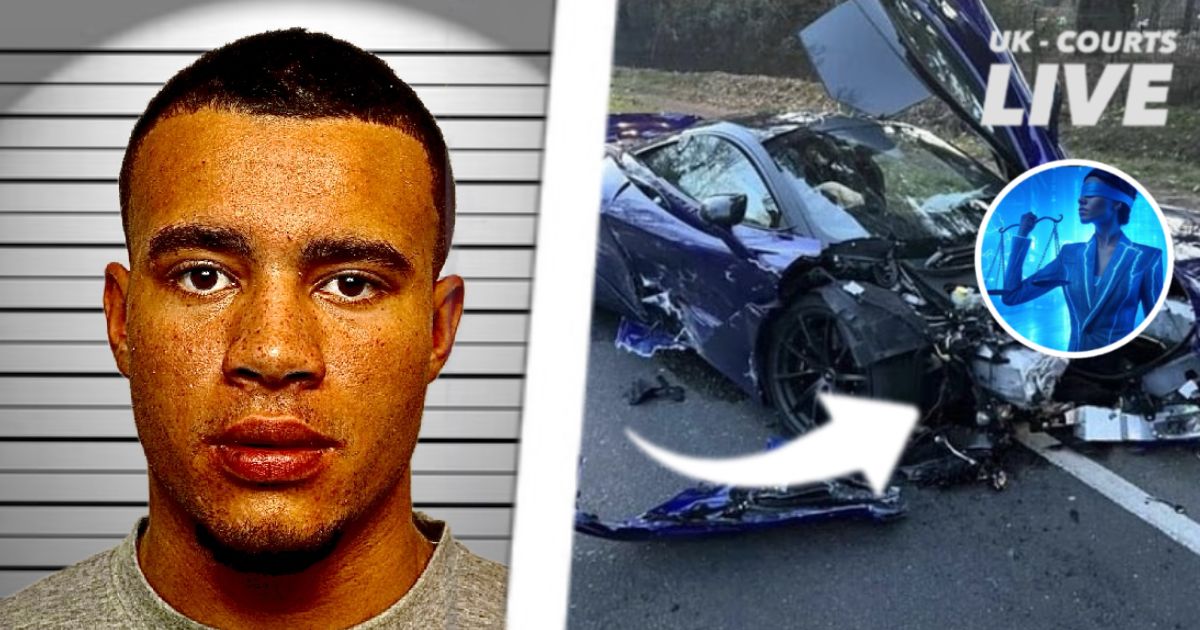HSTikkyTokky Remanded in Custody After Year-Long Manhunt
TikTok influencer Harrison Sullivan, better known by his online moniker HSTikkyTokky, has been arrested after almost a year on the run from Surrey Police.
The 24-year-old social media personality was detained last Friday following a near twelve-month manhunt that began when he failed to appear at Guildford Magistrates’ Court in November 2024. The arrest brings a long and extraordinary chapter in the influencer’s public downfall to an abrupt close.
Sullivan, from Hutton in Essex, had been sought by officers since a crash in Virginia Water, Surrey, in March 2024 involving a £230,000 McLaren 720S supercar. The vehicle, capable of reaching 60mph in under three seconds, was left mangled at the roadside after colliding with another car.
The driver fled the scene before emergency services arrived. In the weeks that followed, police issued an appeal to locate Sullivan, who was believed to have left the country.
An arrest warrant was later issued when he failed to attend court to answer charges including dangerous driving, using a mobile phone at the wheel, failing to stop after an accident, and driving without third-party insurance.
Throughout his time on the run, Sullivan’s behaviour online was as conspicuous as it was ill-advised. Rather than lie low, he appeared to revel in the notoriety, posting videos from locations including Qatar, Spain, and Dubai.
In one video, he insisted he was back “in Brentwood, Essex,” repeatedly citing his postcode while standing in front of palm trees. Hours later, he was filmed in a shopping mall in Dubai, identifiable from visible signage for Jumeirah Golf Estates. Surrey Police, meanwhile, confirmed at the time that he was still wanted in connection with the crash.
On Friday 10 October, officers finally arrested Sullivan in the UK. A Surrey Police spokesperson said: “A 24-year-old man from Hutton, Essex, was arrested for failing to appear at court for dangerous driving.
He appeared at Guildford Magistrates’ Court on Saturday, 11 October and has been remanded ahead of a further court appearance at Staines Magistrates’ Court on Tuesday, 14 October.”
However his appearance at Staines Magistrates’ Court yesterday on the 14th of October was adjourned, and a new hearing has now been set for the 24th of October 2025.” when his case will next be heard.
The arrest ends one of the more peculiar fugitive sagas in recent British social media history. While most defendants who abscond do so discreetly, Sullivan’s year-long evasion was conducted almost entirely in public view.
He posted frequent updates to millions of followers, often addressing the allegations directly and in defiant tones. At one point he shared a mugshot of himself on X, writing:
“I’ll turn myself in tomorrow morning, hold tight yeh,”
Only to later appear in another rant filmed abroad. The contradictions between his posts and verified police information became a running feature of the story, blurring the line between influencer performance and criminal accountability.
The legal implications of his conduct are significant. Under the Bail Act 1976, failure to surrender to custody when required constitutes a separate offence, often resulting in remand when the defendant is finally located. Courts treat absconding from proceedings seriously, particularly when combined with offences carrying potential custodial sentences.
In Sullivan’s case, the combination of dangerous driving allegations and his deliberate flight from justice has compounded his position before the bench. Magistrates in both Guildford and Staines have clear statutory discretion to remand defendants where there is a substantial risk of further offending, failure to surrender, or interference with justice.
It is likely that when the matter returns to court later this month, magistrates will determine whether it remains within summary jurisdiction or is to be sent to the Crown Court for trial or sentencing. Dangerous driving, contrary to section 2 of the Road Traffic Act 1988, carries a maximum penalty of two years’ imprisonment when tried on indictment, alongside mandatory disqualification.
Failing to stop after an accident and driving without insurance are summary-only offences, but the cumulative nature of the alleged conduct, coupled with the prolonged evasion, may influence the sentencing outcome.
From a legal analysis standpoint, the case highlights how social media notoriety can complicate matters that would otherwise remain routine. In previous decades, a defendant absconding in a motoring case might have been traced quietly through administrative processes.
Here, Sullivan’s self-publication effectively documented his own fugitive status, inadvertently providing evidence of international travel and intent to avoid justice. His own posts may yet form part of the evidential timeline, particularly if prosecutors argue they demonstrate a consciousness of guilt.
For all the sensationalism surrounding his arrest, the procedural route ahead is straightforward. The court will first address the outstanding failure-to-appear offence, followed by the substantive driving matters.
Should the magistrates determine their sentencing powers insufficient, the case will proceed to Guildford Crown Court, where a judge will assess both the severity of the original driving offences and the aggravating factor of prolonged non-compliance.
Sullivan’s case is, in essence, a textbook example of how social media celebrity does not exist above or outside the reach of the law. The courts have repeatedly affirmed that public persona offers no mitigation when statutory obligations are ignored.
Whatever public fascination may exist with the flamboyant behaviour of online influencers, British criminal law remains grounded in the principle of equality before the law.




